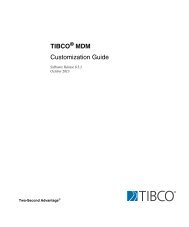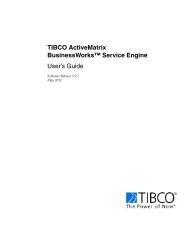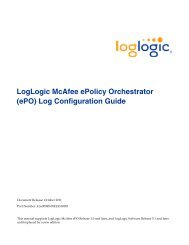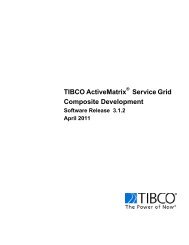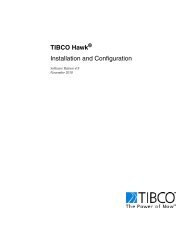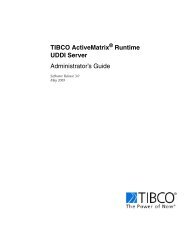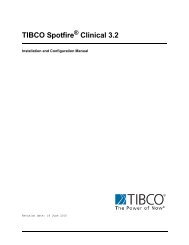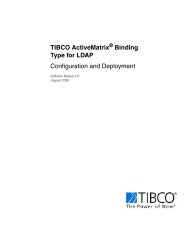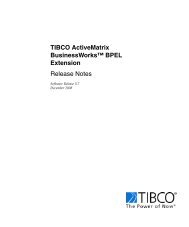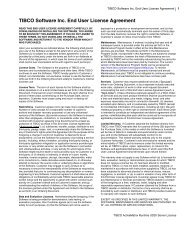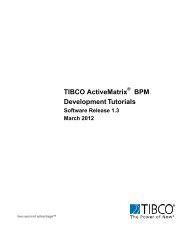TIBCO Spotfire Server 3.2.2 - TIBCO Product Documentation
TIBCO Spotfire Server 3.2.2 - TIBCO Product Documentation
TIBCO Spotfire Server 3.2.2 - TIBCO Product Documentation
You also want an ePaper? Increase the reach of your titles
YUMPU automatically turns print PDFs into web optimized ePapers that Google loves.
Configure the System<br />
Note: This information cannot be entered into the configuration console after this has<br />
been started and connected to the database. If you need to change it later, for instance,<br />
if you move your database server, please refer to the section “Database Connection<br />
Configuration” on page 138. This section also contains more examples of connection<br />
URLs.<br />
Also note that it is possible to use another driver to access your database. <strong>Spotfire</strong><br />
<strong>Server</strong> supports DataDirect (tibcosoftwareinc) by default. See the section “Database<br />
Drivers” on page 47 for a brief description on what other database drivers you can use.<br />
2 The configuration console will prompt for username and password. This information<br />
is identical to the username and password created for the database, described in the<br />
section “Prepare the Database” on page 16.<br />
Comment: If you are using Microsoft SQL <strong>Server</strong> with Integrated Authentication, this<br />
dialog will still show. Click OK without entering any information in the<br />
username and password boxes.<br />
3 After your login information has been verified with the database, the configuration<br />
console will detect that no cluster has been defined. You must set up a new cluster<br />
before you can continue. Note that even if you only have one <strong>Spotfire</strong> <strong>Server</strong> in your<br />
<strong>Spotfire</strong> system, this server will be part of a cluster of one server.<br />
4 The configuration console will ask you if you want to import a configuration file. This<br />
is useful if you have previously exported configuration console settings to a file, for<br />
instance if you are re-installing a <strong>Spotfire</strong> system.<br />
After you have completed these preliminary tasks, the configuration console is ready<br />
to configure your <strong>Spotfire</strong> system. Basic configuration tasks include setup of<br />
authentication and user directory methods, and the adding of <strong>Spotfire</strong> <strong>Server</strong>s to the<br />
cluster.<br />
If you attempt to log into the configuration console and the administrative user is<br />
already logged in, you will be asked if you wish to terminate the other login and<br />
proceed with the current one. Use this with care, especially if there are more than one<br />
administrator of the <strong>Spotfire</strong> system.<br />
5.6 Setting up Authentication<br />
Authentication is the verification of user login information. This information usually<br />
consists of username and password, and is by default stored in the <strong>Spotfire</strong> database.<br />
You can also configure <strong>Spotfire</strong> to authenticate users with an existing LDAP server in<br />
your network, such as a Windows Active Directory <strong>Server</strong>, a Windows NT4 Domain<br />
Controller, or the NTLM protocol.<br />
All of these settings are set in the configuration console, and regardless of which<br />
method you select, the users are always presented with the same login screen when<br />
starting a <strong>Spotfire</strong> client, unless you configure the system to use a single sign-on<br />
method, such as Kerberos or X.509 Client Certificate. For more details on these<br />
choices and recommendation about which to use, please see the section<br />
<strong>TIBCO</strong> <strong>Spotfire</strong>® <strong>Server</strong> <strong>3.2.2</strong> 51 (144)



